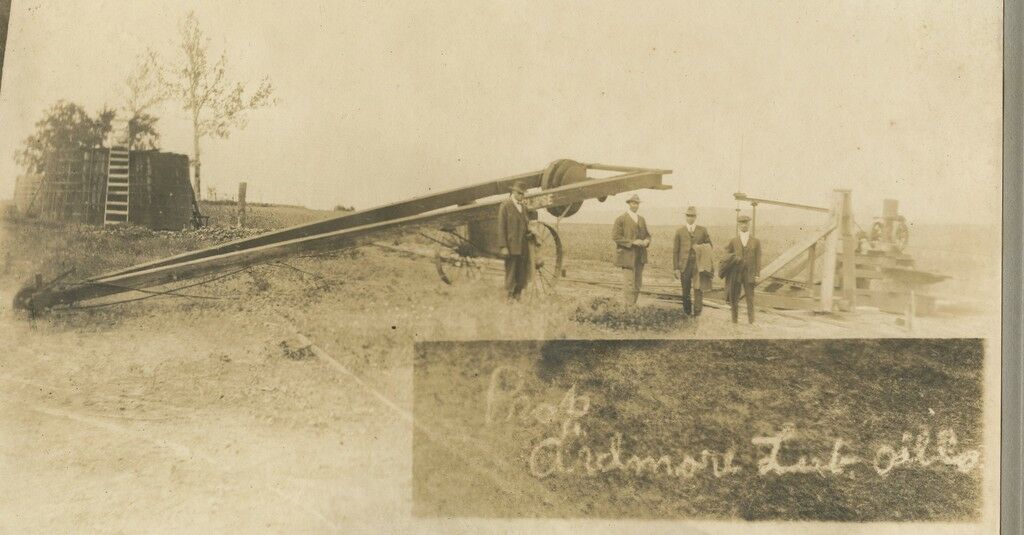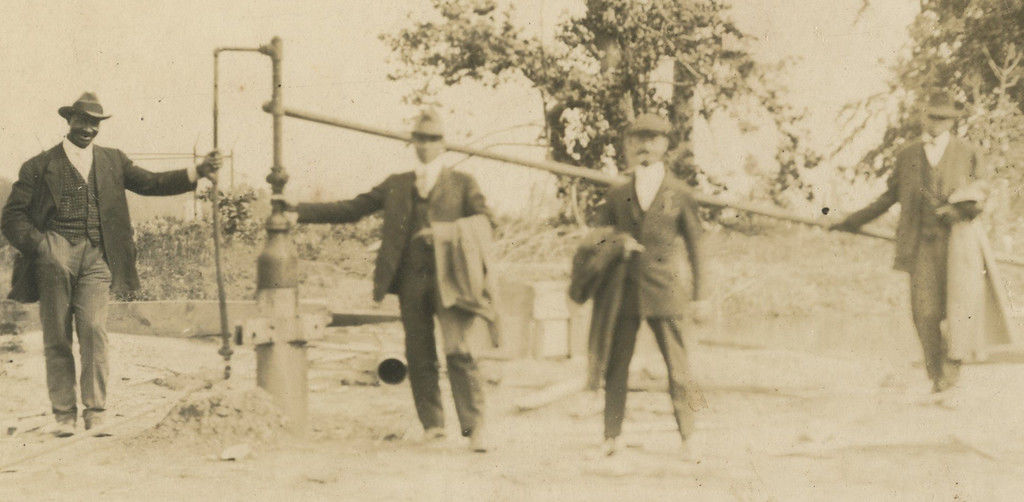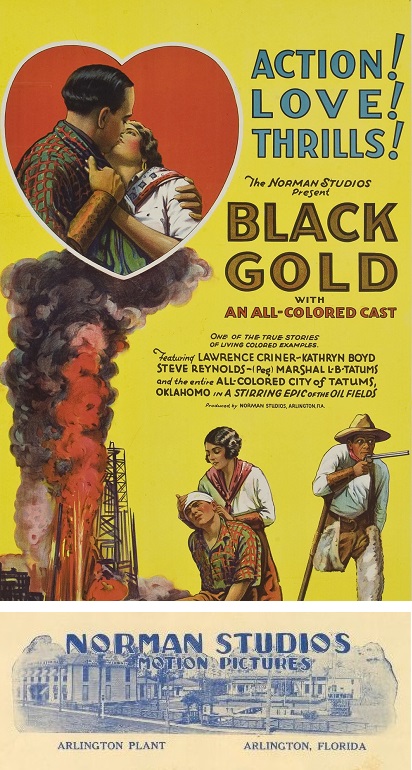African American entrepreneurs began their Oklahoma oil venture in 1917.
Discovery of Oklahoma’s giant Healdton oilfield in August 1913 about 20 miles northwest of Ardmore launched years of investment as petroleum companies competed to secure leases and drill. In the African American community, four entrepreneurs formed the Ardmore Lubricating Oil Company.

Oklahoma’s Daily Ardmoreite reported on August 15, 1918, that Ardmore Lubricating Oil Company moved a Star Rig to explore for oil on land adjacent to the town of Tatums. Image from online auction sale.
Today, East 2nd Street is the heart of the “Deep Deuce” district and is known for its historic jazz and culture. But in 1917, that part of downtown was exclusively for “coloreds,” segregated to the other side of the Santa Fe railroad tracks. It was the era of Gov. William “Alfalfa Bill” Murray’s Jim Crow laws (the Civil Rights Act was still half a century away), but along East 2nd Street African-American businesses and neighborhoods prospered.
Ardmore Lubricating Oil Company moved into offices at 319 and 321 East 2nd Street, across from the Black Dispatch weekly, established two years earlier by Roscoe Dunjee. Advertised as the “Largest circulation Negro journal in Oklahoma,” the paper soon carried Ardmore Lubricating Oil Company promotions encouraging readers to invest.
“Buy Stock in a Home Company – With Men Whom You Know at its Head…100 acres leased and shallow wells producing the high-grade of oil,” declared one ad. The company announced plans “to deepen our 1,360 foot well to the lower pay.” Early investors could get in for the bargain price of $1 a share.
As Ardmore Lubricating Oil operations continued into June 1919, news reports for stockholders were mixed. The company completed a producing well on its 100-acre lease that yielded one barrel of oil a day of “high grade lubrication oil.” The company’s chemist predicted it would be worth $10 a barrel at a time when ordinary oil was selling for $2 dollars per barrel.
In 1920, Ardmore Lubricating Oil began moving equipment to drill a well just outside Tatums, about 80 miles south of Oklahoma City. The company announced it would build its own refinery there to process its especially valuable oil from the Healdton field. Tatums was one of about 50 all-black towns in the former Indian Territory that grew from post Civil War reconstruction. These self-segregated communities were reflective of the times; they remain as reminders of America’s struggle with race and identity.

With a new lab opened in 1920 upstairs at its Oklahoma City offices, the company’s wells reportedly could produce “high grade lubrication oil” and “Icthyol Oil,” a salve for eczema and other skin conditions. Image from online auction sale.
The superintendent, manager and stock salesman of the Ardmore Lubricating Oil, H.E. Baker, published a telegraphed message about the Tatums well site: “We have three wells producing the highest grade and most valuable oil found in the United States, the great drug Icthyol Oil, one of the most sought for and needed products of the world today.”
“Icthyol” was a popular European skin ointment produced from dry distillation of sulfur-rich oil shale, but Ardmore Lubricating Oil Company executives declared they could refine it from Tatums’ crude oil and process it in their own laboratory. In February 1920, the company announced a four-day grand opening to celebrate their new lab upstairs.
“The general public is cordially invited to come and see Kerosene, Automobile Oil and Icthyol,” noted an Ardmore Lubricating Oil promotion. Other ads proposed mutually beneficial business arrangements with merchants, investors, farmers, and consumers.
Increasingly creative financing and uninterrupted stock sales were needed for Ardmore Lubricating Oil to remain solvent. The Black Dispatch in 1921 praised H.E. Baker, noting his company’s “development grows by leaps and bounds…You can get into this company now on the ground floor, $10 is all that you can invest at this time for each member of the family, this will insure at the outset an equal opportunity for all, later on the hundreds of stock holders can get together and determine as to the larger plan of organization.”

Tatums’ townspeople in 1927 hosted and acted in “Black Gold,” a silent picture produced by Norman Studios and featuring an “All Colored Cast.” Posters courtesy IMDB.com and Norman Studios.org.
However, construction of the Ardmore Lubricating Oil refinery in Tatums still had not begun by August 1921. News about the company’s oil wells grew scarce as Baker sold his own leases. The last appeals for new investors appearing in the Black Dispatch were nevertheless optimistic:
“Wonderful Opportunities In Larger Faith And Deeper Hole,” proclaimed the newspaper. “To anyone with a limited amount of brains it can be seen that a little more faith and a deeper hole will bring into the hands of the Negro landholders in this section the millions of dollars, which their white neighbors all around them are reaping hourly from the derricks that have lunched great holes in the earth and are spouting liquid treasure everywhere.”
A few years later, but too late for Ardmore Lubricating Oil, the area around Tatums did experience an oil boom that was celebrated on the big screen. In 1927, townspeople hosted the making of Black Gold, a silent picture produced by Norman Studios and distributed to all-black theaters the next year. The Florida-based studio described its movie as a “stirring epic of the oil fields” with a cast including, “U.S. Marshall L.B. Tatums. and the entire all-colored City of Tatums, Oklahoma.”
The action-packed melodrama featured Ace Brand, his sweetheart Alice, and a one-legged cowboy (named Peg), who overcame both adversity and injustice in the oil patch. While the film’s happy ending delivered an oil gusher, Ardmore Lubricating Oil Company did not.
Few financial records remain about the company, but Gateway to Oklahoma History and the Black Dispatch’s archives offer more context to this almost forgotten story from U.S. petroleum history.
The American Oil & Gas Historical Society (AOGHS) preserves U.S. petroleum history. Become an AOGHS supporting member and help maintain this energy education website and expand historical research. For more information, contact bawells@aoghs.org. © 2020 Bruce A. Wells.
Citation Information – Article Title: “Ardmore Lubricating Oil Company.” Author: Aoghs.org Editors. Website Name: American Oil & Gas Historical Society. URL: https://aoghs.org/stocks/ardmore-lubricating-oil-company. Last Updated: February 21, 2024. Original Published Date: July 4, 2019.

Ardmore Lubricating Oil Company opened offices in this building on East 2nd Street in a segregated district of downtown Oklahoma City known for its prospering businesses and jazz music nightlife. Photo courtesy The Black Dispatch, Oklahoma City, April 20, 1922, Vol. 7, No. 20.
Decades of production from the Healdton oilfield would yield more than 200 million barrels of oil — but the prolific field left hundreds of forgotten petroleum companies hidden in its exploration and production history.
Oil production from the Healdton field was shallow, averaging about 1,000 feet, and the low cost of drilling attracted many small ventures that operated on capital raised by aggressive stock sales. State “Blue Sky” laws had yet to restrain advertising excesses and promotions. Competition for investors often was fierce (see Homestead Oil Company).
Ardmore Lubricating Oil Company
When a group of foundering Coffeyville, Oklahoma, investors gave up on their 100-acre oil lease in 1917, four African American entrepreneurs bought out the venture and its unfinished 1,360-foot-deep well, which had encountered “several light sands” and a water-filled borehole.
Wilson Newman, J.C. Pratt, S.M. Holland, and Heston Welborn formed the Ardmore Lubricating Oil Company, capitalized at $50,000, and set up offices on East 2nd Street in Oklahoma City.

Oklahoma’s Daily Ardmoreite reported on August 15, 1918, that Ardmore Lubricating Oil Company moved a Star Rig to explore for oil on land adjacent to the town of Tatums. Image from online auction sale.
Today, East 2nd Street is the heart of the “Deep Deuce” district and is known for its historic jazz and culture. But in 1917, that part of downtown was exclusively for “coloreds,” segregated to the other side of the Santa Fe railroad tracks. It was the era of Gov. William “Alfalfa Bill” Murray’s Jim Crow laws (the Civil Rights Act was still half a century away), but along East 2nd Street African-American businesses and neighborhoods prospered.
Ardmore Lubricating Oil Company moved into offices at 319 and 321 East 2nd Street, across from the Black Dispatch weekly, established two years earlier by Roscoe Dunjee. Advertised as the “Largest circulation Negro journal in Oklahoma,” the paper soon carried Ardmore Lubricating Oil Company promotions encouraging readers to invest.
“Buy Stock in a Home Company – With Men Whom You Know at its Head…100 acres leased and shallow wells producing the high-grade of oil,” declared one ad. The company announced plans “to deepen our 1,360 foot well to the lower pay.” Early investors could get in for the bargain price of $1 a share.
As Ardmore Lubricating Oil operations continued into June 1919, news reports for stockholders were mixed. The company completed a producing well on its 100-acre lease that yielded one barrel of oil a day of “high grade lubrication oil.” The company’s chemist predicted it would be worth $10 a barrel at a time when ordinary oil was selling for $2 dollars per barrel.
In 1920, Ardmore Lubricating Oil began moving equipment to drill a well just outside Tatums, about 80 miles south of Oklahoma City. The company announced it would build its own refinery there to process its especially valuable oil from the Healdton field. Tatums was one of about 50 all-black towns in the former Indian Territory that grew from post Civil War reconstruction. These self-segregated communities were reflective of the times; they remain as reminders of America’s struggle with race and identity.

With a new lab opened in 1920 upstairs at its Oklahoma City offices, the company’s wells reportedly could produce “high grade lubrication oil” and “Icthyol Oil,” a salve for eczema and other skin conditions. Image from online auction sale.
The superintendent, manager and stock salesman of the Ardmore Lubricating Oil, H.E. Baker, published a telegraphed message about the Tatums well site: “We have three wells producing the highest grade and most valuable oil found in the United States, the great drug Icthyol Oil, one of the most sought for and needed products of the world today.”
“Icthyol” was a popular European skin ointment produced from dry distillation of sulfur-rich oil shale, but Ardmore Lubricating Oil Company executives declared they could refine it from Tatums’ crude oil and process it in their own laboratory. In February 1920, the company announced a four-day grand opening to celebrate their new lab upstairs.
“The general public is cordially invited to come and see Kerosene, Automobile Oil and Icthyol,” noted an Ardmore Lubricating Oil promotion. Other ads proposed mutually beneficial business arrangements with merchants, investors, farmers, and consumers.
Increasingly creative financing and uninterrupted stock sales were needed for Ardmore Lubricating Oil to remain solvent. The Black Dispatch in 1921 praised H.E. Baker, noting his company’s “development grows by leaps and bounds…You can get into this company now on the ground floor, $10 is all that you can invest at this time for each member of the family, this will insure at the outset an equal opportunity for all, later on the hundreds of stock holders can get together and determine as to the larger plan of organization.”

Tatums’ townspeople in 1927 hosted and acted in “Black Gold,” a silent picture produced by Norman Studios and featuring an “All Colored Cast.” Posters courtesy IMDB.com and Norman Studios.org.
However, construction of the Ardmore Lubricating Oil refinery in Tatums still had not begun by August 1921. News about the company’s oil wells grew scarce as Baker sold his own leases. The last appeals for new investors appearing in the Black Dispatch were nevertheless optimistic:
“Wonderful Opportunities In Larger Faith And Deeper Hole,” proclaimed the newspaper. “To anyone with a limited amount of brains it can be seen that a little more faith and a deeper hole will bring into the hands of the Negro landholders in this section the millions of dollars, which their white neighbors all around them are reaping hourly from the derricks that have lunched great holes in the earth and are spouting liquid treasure everywhere.”
A few years later, but too late for Ardmore Lubricating Oil, the area around Tatums did experience an oil boom that was celebrated on the big screen. In 1927, townspeople hosted the making of Black Gold, a silent picture produced by Norman Studios and distributed to all-black theaters the next year. The Florida-based studio described its movie as a “stirring epic of the oil fields” with a cast including, “U.S. Marshall L.B. Tatums. and the entire all-colored City of Tatums, Oklahoma.”
The action-packed melodrama featured Ace Brand, his sweetheart Alice, and a one-legged cowboy (named Peg), who overcame both adversity and injustice in the oil patch. While the film’s happy ending delivered an oil gusher, Ardmore Lubricating Oil Company did not.
Few financial records remain about the company, but Gateway to Oklahoma History and the Black Dispatch’s archives offer more context to this almost forgotten story from U.S. petroleum history.
The American Oil & Gas Historical Society (AOGHS) preserves U.S. petroleum history. Become an AOGHS supporting member and help maintain this energy education website and expand historical research. For more information, contact bawells@aoghs.org. © 2020 Bruce A. Wells.
Citation Information – Article Title: “Ardmore Lubricating Oil Company.” Author: Aoghs.org Editors. Website Name: American Oil & Gas Historical Society. URL: https://aoghs.org/stocks/ardmore-lubricating-oil-company. Last Updated: February 21, 2024. Original Published Date: July 4, 2019.


